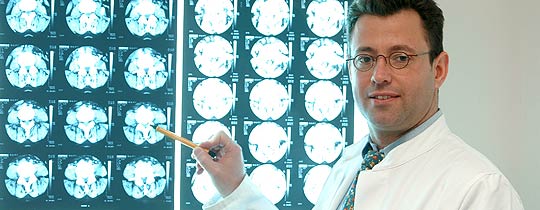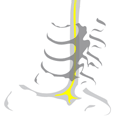Dr. Elmar Patz

Bony narrowing of the spinal canal (foraminal or spinal stenosis) in the cervical or lumbar spine
Narrowing of the spinal canal is either a congenital defect or degenerative in nature (acquired through wear and tear), although it is generally a combination of both. With such narrowing, the inside diameter of the spinal canal may become significantly reduced in size due to bony spurs at the zygapophyseal joints due to degenerative changes. At the same time the openings where the nerves exit (neuroforamen) may also become constricted, resulting in nerve root compression syndrome. Bony narrowing of the spinal canal in the lumbar spine may be aggravated for example by broad-based bulging of the disc and – especially in the case of cervical spine - by bony outgrowths on the rear edge of the vertebral body (spondylophytes). The thickening of ligaments or vertebral body slipping may also play a role here.
Symptoms:
In terms of clinical symptoms we have to differentiate between the cervical and the lumbar spine. In the case of the cervical spine constriction causes direct compression of the spinal cord (myelon). This may impair the blood supply to the relevant part of the spinal cord and subsequently damage it (myelopathy). Patients complain of pain, sometimes radiating into the arm, and frequently on both sides of the body. Where there is damage to the spinal cord, we also see unsteady gait, palsy of the arms and/or legs as well as loss of sensitivity, especially in the arms. Reflexes in the arms are either depressed or normal, and often legs in the legs. Impairment of bladder and bowel function or problems with potency occur later on. With narrowing of the bone in the canal of the cervical spine, the symptoms revolve around stenosis of an individual nerve root and are the same as for a slipped disc.
In the case of the lumbar spine there may be nerve root compression as well as load-dependent impairment of the blood supply to the cauda equina fibres in the area of constriction. Clinically this results in the typical load-dependent pain which radiates into both legs, though it sometimes only occurs on one side of the body (claudicatio spinalis). This may cause numbness and less frequently palsy of the legs as well. Such patients are often only capable of walking a few hundred yards due to pain. If the pain eases significantly on bending forwards, it is almost certain that the problem is caused by narrowing of the spinal canal in the lumbar spine.
Diagnosis:
Diagnosis involves taking an X-ray of the cervical and/or lumbar spine as well as a CT scan. With narrowing of the canal in the cervical spine an MRI scan is also carried out. Sometimes no clear-cut diagnosis of "spinal canal stenosis" can then be made, and it is not always possible to immediately identify the vertebral segment affected on the basis of the clinical symptoms. This is why further examinations or tests are often necessary as well, e.g. using contrast medium (myelography) or special MRI scans. Where findings are clear-cut, surgical decompression of the bone around the spinal cord and/or nerve root should take place.
Surgery:
At our practice all operations on the spine are performed using microsurgery, involving an operating microscope. In the case of the cervical spine the spinal canal is enlarged from the back (dorsally) by removal or "opening-up" of the vertebral arches. Foraminal stenosis of the cervical spine is also corrected dorsally. Broad-based herniated discs with narrowing of the spinal canal are cut away from the front (ventrally). Protruding bone of the vertebral bodies (osteophytes) is removed and a prosthetic disc inserted. Bony narrowing in the lumbar spine is corrected by dorsal removal of the bone causing constriction. The aim here is to ensure minimally invasive access using the smallest possible incision in the skin. It is only ever made unilaterally, even if both sides are undergoing decompression.
Also see:
» Slipped disc
» Nerve compression syndrome of the hand
» Nerve compression syndrome of the elbow
» Chronic backache
